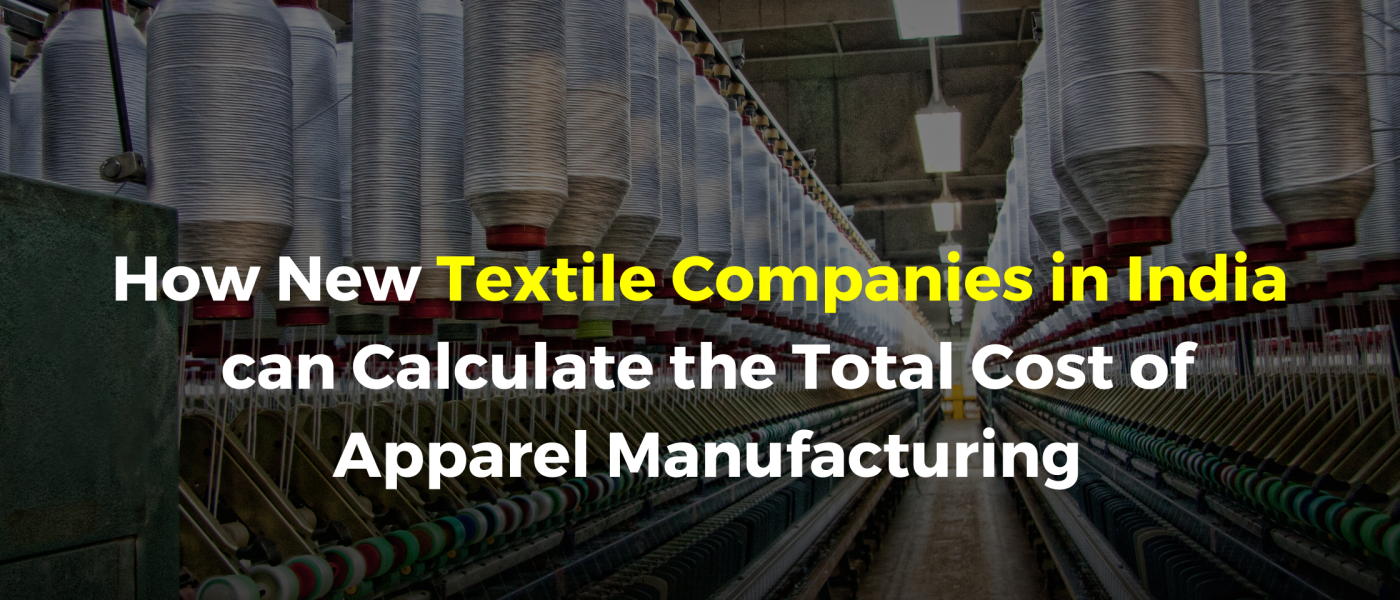Manufacturing costs play an important role for textile manufacturers in India as it helps them decide the three main factors of their businesses – product price, product-customer fit, and customer acceptance. Whether you want to set up a simple online fabric store in India or sell rare spider silk yarn across online yarn markets, understanding how much it costs to turn raw materials into finished goods and how much it takes to manufacture them may help you determine the product’s long-term viability. New textile companies in India can understand these costs using simple formulas. While early estimates are not always accurate since the production process often raises unexpected costs, the calculations give insights into product profitability, investment, and funding scopes.
In this post, we will share useful information on how new textile manufacturers can calculate the total cost of apparel manufacturing.
What is Manufacturing Cost?
Manufacturing cost is different from production cost. Production cost includes manufacturing cost, and manufacturing services cost. Manufacturing costs are direct and indirect expenses associated with producing a product (for example, cotton fabric) from scratch, which includes raw material, machinery, overhead, labor, supply chain, inventory, etc.
Some of the common direct and indirect manufacturing costs include:
- Procuring raw material
- Wages and salaries directly involved in the production process, such as laborers, quality controllers, production heads, machinery operators, factory managers, IT staff, and security personnel
- Production center cost (rent or EMI)
- Hardware and software used within the manufacturing unit, such as computers, software applications, and network and communication systems
- Factory utility costs, such as water, gas, and electricity
- Insurance and taxes related to the manufacturing unit
- Machinery parts, supplies, and maintenance cost
- Depreciation of assets
- Supplies and accessories are required to run the factory but not directly related to fabric production, such as food, drinks, stationery, furniture, etc.
What is Production Cost
Production cost is a broader term that includes all the expenditures associated with creating the end product. This includes manufacturing (direct and indirect) and non-manufacturing costs, like research and development, design, marketing, distribution, salaries and wages of the CEO, CFO, accountants, etc., and other administrative costs to run the company.
Calculating Manufacturing Cost Per Unit for a New Textile Product
The provided formula is applicable for determining the cost of any new product, not exclusively limited to textiles.
Three primary costs that affect the total cost of product manufacturing are direct material cost, direct labor cost, and overhead cost.
Direct Material Cost
It is basically the cost of raw materials required to manufacture a product. In the case of textile manufacturers in India specializing in yarn, cotton or jute fiber is a raw material. Direct material cost is the expenditures incurred while procuring the essential raw material. The formula is calculated as follows:
Direct Material Cost = Existing Raw Material + Purchased Raw Material – Remaining Raw Material
For example, a textile manufacturer in India currently has 1000 kgs of cotton fiber worth $10000 and requires an additional 1000 kgs of fiber worth $10000 to complete an order from the online yarn market, TEXchange Global. At the end of the production, if the company has 250 kgs of raw material worth $2500 remaining, then their direct material cost would be calculated as follows:
$10,000 (existing material cost) + $10,000 (newly purchased cost) – $2,500 (remaining material cost) = $17500
The direct material cost may vary depending on order volume and manufacturing output capacity. For instance, bulk orders and reduced output may lower the raw material cost.
Direct Labor Cost
A textile company with a manufacturing unit and an online fabric store in India may have hired people to perform different jobs, like accounting, marketing, litigation, business development, and production. Direct laborers are production line staff who are directly involved in the manufacturing process, such as production in charge, machine operators, QC managers, laborers, etc. And any expenses that relate to direct laborers, such as their salary, wage, insurance, incentives, benefits, and medical expenses, are considered direct labor costs.
Direct labor cost is hence calculated with the following formula:
Direct Labor Cost Per Unit = Direct Labor Hourly Rate X Direct Labor Hours
Direct Labor Cost for a Month = Direct Labor Cost Per Unit X Monthly Product Output
Direct labor hourly rate = (rate per hour + payroll taxes + fringe benefits) / number of working hours in a month
Let’s assume the total rate per hour, payroll taxes, and fringe benefits for all production line staff in a pay period is $1500. The number of hours worked during the period is 1000 hours.
Therefore, Direct labor hourly rate = $1500 / 1000 = $1.5 per hour
Direct labor hour = units produced / labor hours
Now let’s calculate the number of hours required to produce the textile products. Let’s assume the online fabric store in India produced 50000 meters of fabric during the pay period.
Therefore, Direct labor hour = 500000 meters / 1000 hours = 50 hours per meter.
Finally, the Direct Labor Cost Per Unit will be as follows:
$1.5 per hour X 50 hours per meter = $0.03 per meter
And the Direct Labor Cost Per Month will be as follows:
$0.03 per unit X 500000 meters = $1,500
Overhead Cost
The overhead cost is the most difficult and time-consuming to calculate in a production business. This is because textile manufacturers in India consider various expenses as overhead costs, right from the income tax of the General Manager to the insurance of the person who serves coffee. However, the following expenses should be included in a production line:
- Indirect Labor Cost
- Indirect Material Cost
- Repair and Maintenance Cost
- Insurance and Tax
- Depreciation
The total overhead cost for product manufacturing is the sum of every expense incurred.
Suppose the total overhead cost for a pay period for the textile manufacturer is $3500. Then the per unit overhead cost is calculated as follows:
Manufacturing Overhead Cost Per Unit = Total Overhead Cost / Total Units Produced in a Month.
So, the calculations should be:
$35000 total overhead cost / 500000 fabric meters = $0.07 Manufacturing Overhead Cost Per Unit for the month
How to Calculate the Total Manufacturing Cost of a New Product for Textile Companies in India
The formula to calculate the total manufacturing cost for any product, be it yarn, fabric, or garment, is as follows.
Total Manufacturing Cost = Direct Material Cost + Direct Labor Cost + Overhead Cost of the Pay Period
From the above example, this can be determined as follows:
Direct Material Cost: $17500
Direct Labor Cost: $1500
Overhead Cost: $35000
Finally, the Total Manufacturing Cost Per Month = $54000 ($17500 + $1500 + $35000)
To find the cost of manufacturing per unit, you can simply divide the total manufacturing cost per month by the number of units/meters produced in the month. So, $54000 / 500000 = $.108
Regardless of your trading choices, whether you sell cotton fabric wholesale online via TEXchange or choose DMI as your trading partner, determining the cost of textile manufacturing is crucial as it will help you achieve the revenue targets or navigate losses expertly. Calculating the total manufacturing costs can unveil previously hidden inefficiencies, expose flawed pricing strategies, and identify wastage of valuable resources. Need trading tips? Follow our blogs here and Damodar Menon International.




